
new_insights_into_business_studen
.pdf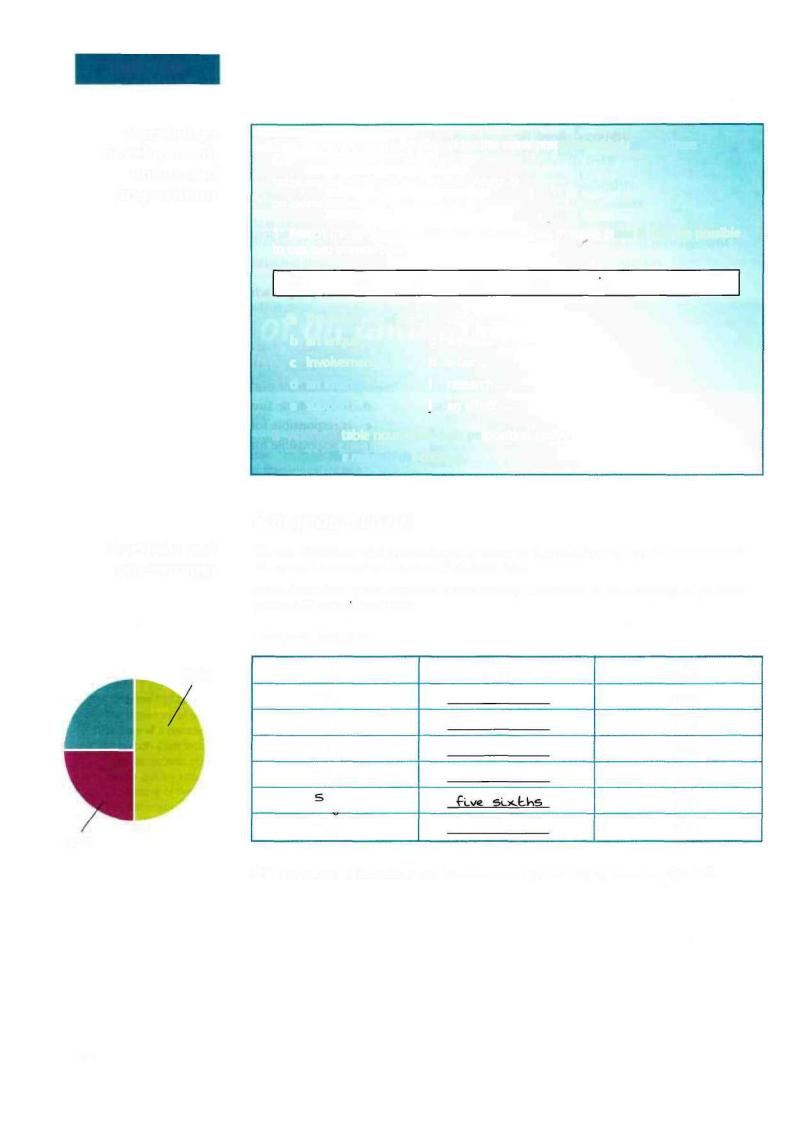
unit ten
Vocabulary development: nouns and prepositions
Some nouns are always followed by the same preposition(s). Look at these examples from the text on page 98.
takesresponsibilityforthe validity(para2)
an advertisement for the company (para 9)
1 Match the prepositions with the nouns below. In some cases it may be possible to use two prepositions.
with |
for |
of |
on |
into |
in |
|
a |
the result... of |
f |
satisfaction ... |
|
|
|
b an enquiry ... |
g |
a percentage |
... |
|
||
c |
involvement... |
h |
a tax ... |
|
|
|
d |
an interest... |
i |
research ... |
|
|
|
e |
support... |
j |
an effect... |
|
|
|
2 Add a suitable noun after each preposition above.
Example: The result of the changes.
Fractions and
percentages
50%
25%
Language Focus
We use fractions and percentages to express the relative values of one amount compared to another. Look at the examples.
More than halfofourpersonnel (51%) already own shares in the company. A quarter (25%) will qualify next year.
Complete the table. |
|
|
-v/32 |
a half |
50% |
|
66% |
|
-/4 |
|
25% |
-/4 |
|
75% |
-/5 |
|
|
|
40% |
|
~u |
|
|
|
83% |
|
|
|
|
-lio |
|
90% |
•• For more information on fractions and percentages, turn to page 168.
100
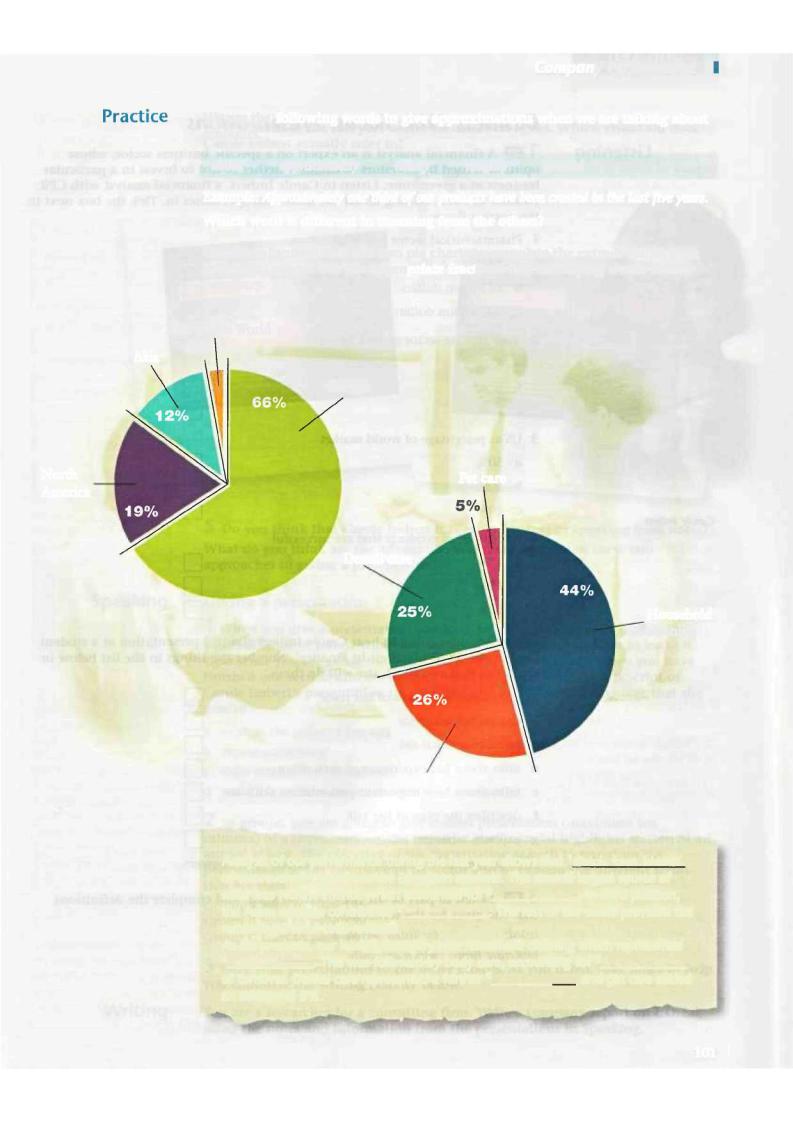
North
America
Company Performance I
We use the following words to give approximations when we are talking about amounts.
about |
approximately |
nearly |
roughly |
around |
Example: Approximately one third of our products have been created in the last five years.
Which word is different in meaning from the others?
Use the information in the two pie charts to complete the extract below from an annual report. Use the appropriate fractions and modifying words where necessary.
Rest of the World
3 %
Asia
Europe
Pet care
Dental care
Household cleaning
Body care
Analysis of our performance during the last year shows that 1aboub Ltoo Lhlrds of our revenue came from the European markets. The second largest source of
sales was North America which accounted for2 |
|
. |
In third position, |
||
the Asian markets contributed 3 |
|
. The rest of the |
world provided the |
||
remaining 3% of total revenue.
As for products, our leading category was household cleaning which represented
4 |
|
. This was followed by body care, accounting for5 |
||||
|
|
|
|
|
|
|
of turnover. Dental care represented a further6 |
. and pet care added |
|||||
an additional 5%. |
|
|
|
|
||
101
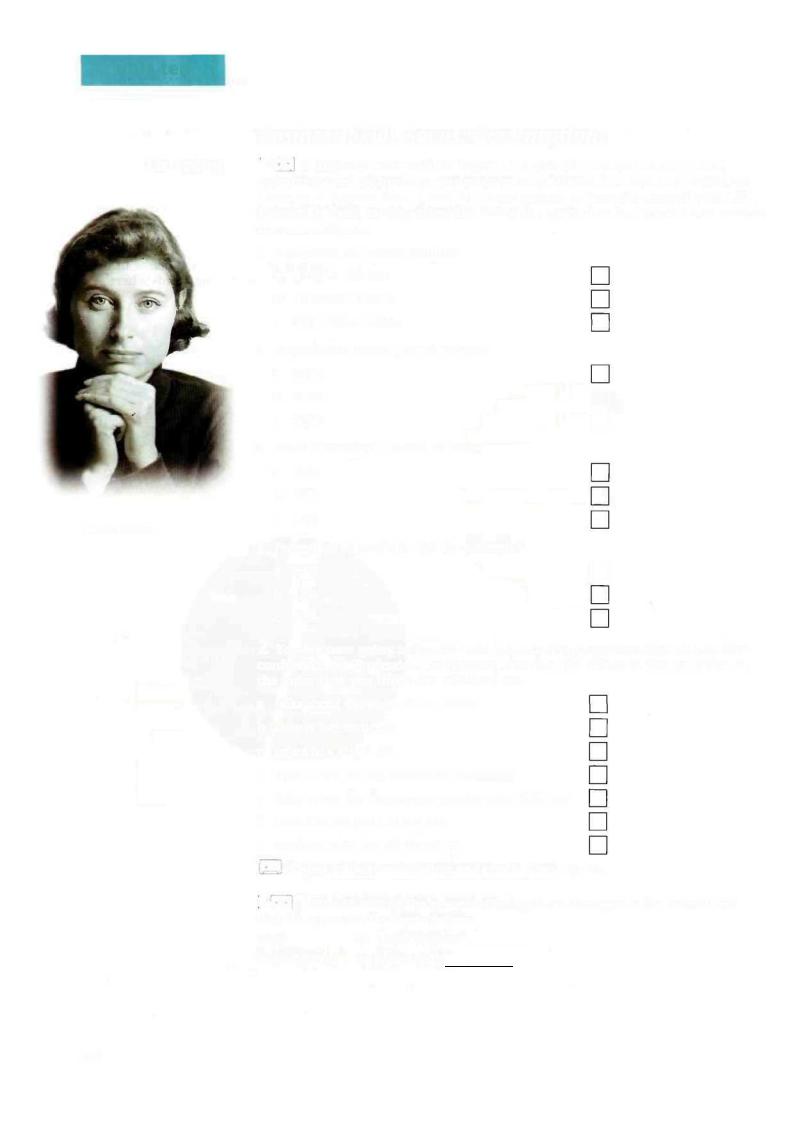
unit ten
Business Skills Focus: Presentations
Listening 1 [^ A financial analyst is an expert on a specific business sector, whose opinion is used by investors to decide whether or not to invest in a particular business at a given time. Listen to Carole Imbert, a financial analyst with CPR Finance in Paris, talking about the sector she specialises in. Tick the box next to the correct figure.
Carole Imbert
1 Pharmaceutical sector turnover
a3 billion dollars
b13 billion dollars
c300 billion dollars
2Approximate sector growth per year a 5.0%
b6.5%
c7.5%
3US as percentage of world market a 50%
b 30% c 40%
4Percentage of products that are successful
a13%
b15%
c50%
•
•
•
2 You are now going to hear Carole Imbert giving a presentation at a student conference on 'Professions in Finance'. Number the things in the list below in the order that you think she will do them.
atalks about the 'tools of her trade'
bthanks her audience
crefers to a visual aid
dtalks about her experience of presenting
etalks about how important presentation skills are
fdescribes the plan of her talk
gexplains what her job involves
ra Listen to the presentation and check your answers.
51^3 Listen to part of the presentation again and complete the definitions that she gives for the terms below.
listed: |
by 'listed' we mean |
|
brokerage firms: which are really
102
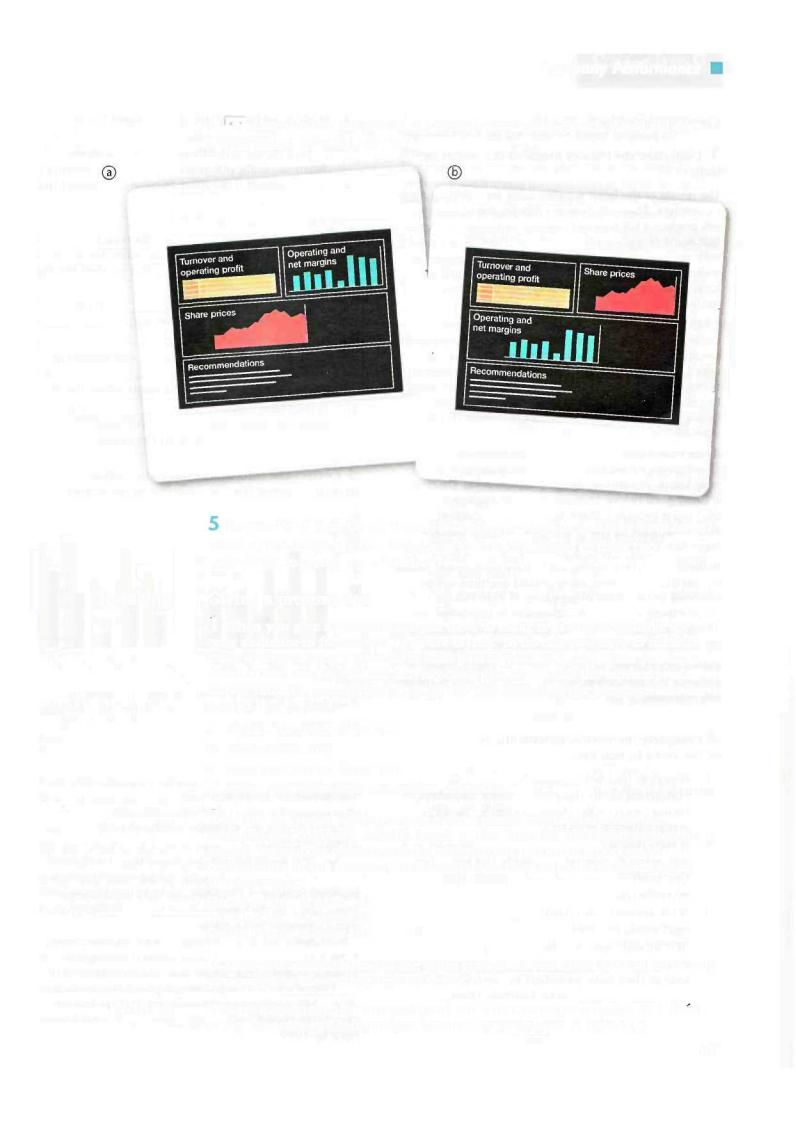
Company Performance
4 i^J Listen to the last part of the presentation again. Which visual aid does Carole Imbert actually refer to?
Do you think that Carole Imbert is reading her text or speaking from notes?
What do you think are the advantages and disadvantages of these two approaches to giving a presentation?
Speaking Giving a presentation
1 When you give a presentation you have to make it as easy as possible for your audience to follow what you are saying. To do this you have to make it clear what you are going to do in each part of your talk, and when you have finished one section and are moving on to the next. Read the tapescript of Carole Imbert's presentation on page 163 and underline the language that she uses to
aexplain the order of her talk
brepeat something
cdraw attention to visual aids
dmake a transition from one section to another
2 In groups, you are going to give a short presentation (maximum ten minutes) of a company's results, based on the financial highlights section of an annual report. The objective of the presentation is both to report on the performance of the company in its sector and to explain the different terms that are used.
Group A turn to page 155 Group B turn to page 159 Group C turn to page 161
3 Give your presentations to the other groups. As you listen, take notes to help you complete the writing activity below.
Writing You are a researcher for a consulting firm. Write a company report on L'Oreal, using the notes and information from the presentations in Speaking.
103
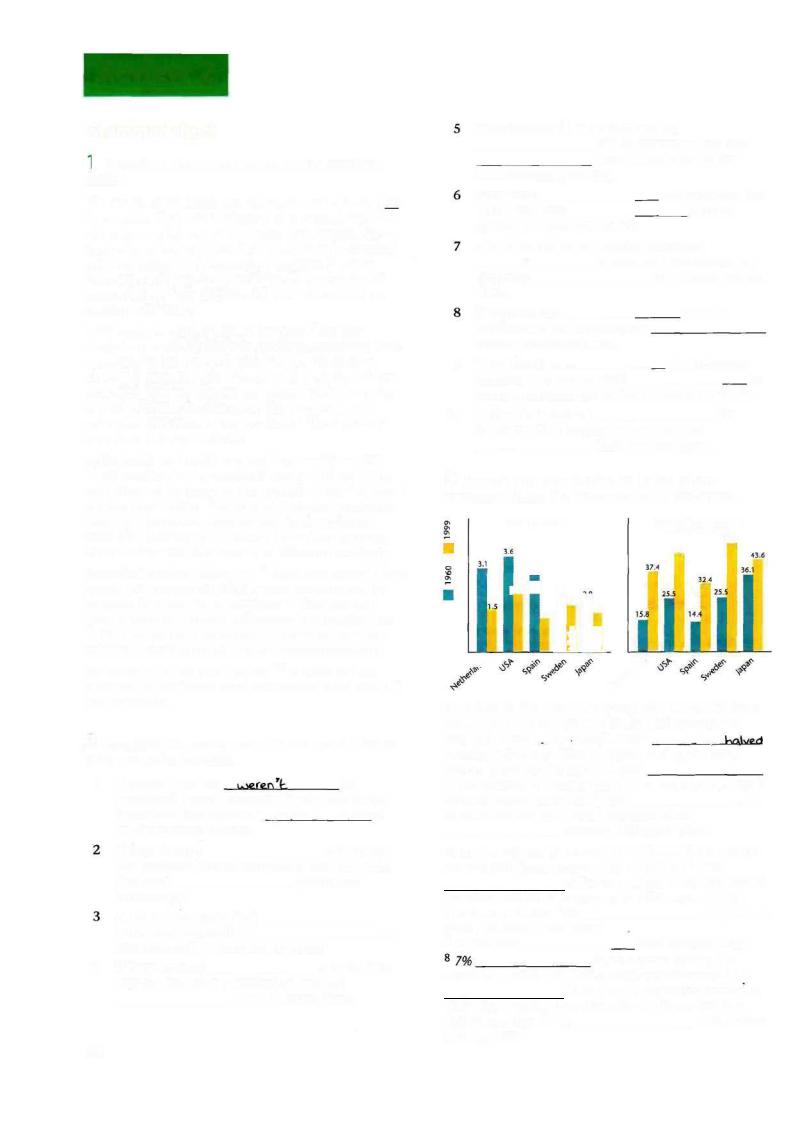
Review 2
Grammar check
I Underline the correct forms of the words in italics.
The results of the latest supplier audit are 1 already / still incomplete. They will2 process / be processed, then we will prepare a full report. However, early analysis shows that some of our suppliers 3 still / yet haven't complied with our policy. The companies concerned 4 will be informing / will be informed that failure to comply will mean that we5 are discontinuing I will discontinue our dealings with them.
6 Although / In spite of a lot of progress 7 has been made / has made to eliminate products containing toxic materials, further work remains 8 to do / to be done, which 9 is going to / will10 enable / let us to include an ecological label on most of our goods. We 11 are going to I will probably be able to do this next year, and guarantee that none of our products12 have tested / havebeentestedonanimals.
As for health and safety and working conditions, we
13 will produce / will be produced new guidelines in the near future. A summary of the problem areas 14/s given / is being given below. 15 In spite of/ Although protective clothing is provided, there are too many accidents. Additional training will 16 allow / let workers become more familiar with the hazards of different machinery.
Regarding workers' rights, we 17 have been agreed / have agreed that companies using unpaid overtime will be removed from our list of suppliers. 18 Even though / Despite there are national differences in legislation, we 19 will / are going to continue our efforts to introduce minimum working conditions for overseas suppliers.
We expect that this year's survey 20 is going to / will enhance the performance of the company and maintain our reputation.
2 Complete the sentences with the correct forms of the verbs in brackets.
1 |
|
If people (not be) |
|
|
|
so |
|||||||
|
|
concerned about the environment nowadays, |
|||||||||||
|
|
businesses (not develop) |
^T*.Mr\TL develop |
||||||||||
|
|
environmental polices. |
|
|
|
|
|
||||||
|
|
If they (know) |
|
|
the market |
||||||||
|
|
|
|
|
|
|
|
|
|
|
|
|
|
|
|
was going to expand so quickly last year, they |
|||||||||||
|
|
(increase) |
|
production |
|||||||||
|
|
|
|
|
|
|
|
|
|
|
|
|
|
|
|
accordingly. |
|
|
|
|
|
||||||
|
|
If UK interest rates (fall) |
|
|
|
|
|
||||||
|
|
|
|
|
|
|
|
|
|
|
|
||
|
|
next week, we (switch) |
|
|
|
|
|
our |
|||||
|
|
|
|
|
|
|
|
||||||
|
|
investments into another currency. |
|||||||||||
4 |
If they (reduce) |
|
|
tariffs this |
|||||||||
|
|
|
|
|
|
||||||||
|
year as they have promised to, we (do) |
||||||||||||
|
|
|
|
|
|
more business there. |
|||||||
|
If biodegradable materials (not be) |
|||||||||||||||||
|
|
|
|
|
|
|
|
|
still so expensive, we (use) |
|||||||||
|
|
|
|
|
|
|
|
them more often in our |
||||||||||
|
|
manufacturing process. |
|
|
|
|
|
|
|
|||||||||
|
If we (buy) |
|
|
|
|
|
. shares before the |
|||||||||||
|
|
crash, we (lose) |
|
|
|
|
a lot of |
|||||||||||
|
|
|
|
|
|
|
|
|
|
|
|
|
|
|
|
|
|
|
|
|
money. I'm glad we didn't. |
|
|
|
|
|
|
|
|||||||||
|
If sales in the Indian market (increase) |
|||||||||||||||||
|
|
|
|
|
|
|
|
|
as they are expected to, we |
|||||||||
|
|
(expand) |
our production site |
|||||||||||||||
|
|
there. |
|
|
|
|
|
|
|
|
||||||||
|
If we (not cut) |
|
|
|
|
|
costs in |
|||||||||||
|
|
production, we (not survive) |
||||||||||||||||
|
|
the last economic crisis. |
|
|
|
|
|
|
|
|||||||||
9 |
If we (have) |
|
|
|
|
the necessary |
||||||||||||
|
|
information, we (be able) |
|
|
|
|
|
|
|
to |
||||||||
|
|
make a decision, but at the moment we don't. |
||||||||||||||||
10 |
If they (not deliver) |
|
|
|
|
|
the |
|||||||||||
|
|
|
|
|
||||||||||||||
|
|
goods on time tomorrow, we (not use) |
||||||||||||||||
|
|
|
|
|
|
|
|
their services again. |
||||||||||
3 Correct the information in italics where necessary, using the information in the graph.
Births per woman |
Working Women as % of |
||
|
|
|
total labour force |
|
|
|
51.5 |
|
|
|
46.5 |
|
2.9 |
|
|
|2.1 |
I |
2.1 |
|
^ |
|
1.2 i |
y |
|
|
|
|
If we look at the chart concerning the number of births per woman, we can see that in the Netherlands, for
example, these 1_ mnrcthnndmMrrt~ mnre (-Un,r> p
between 1960 and 1999. In Japan, during the same
period, there was2 a slight increase
in the number of children born. This was also the case in
Sweden where births also 3 rose |
|
. In |
|
all countries the birth rate 4 remained stable |
|
||
|
between 1960 and 1999. |
|
|
As for the number of women in the labour force, we can see that this figure increased by more than 5 25%
in Sweden, where more than half of
the total number of employees in 1999 were women.
There was a similar 6 rise |
|
in Spain. In |
||
|
|
|
|
|
Japan, however, there was a |
||||
7 big increase |
|
. with approximately |
||
|
|
|
|
|
|
|
more women joining the |
||
workforce. In the USA, where only approximately 9 ; /j |
||||
of the female population worked in 1960, the total number of female employees reached
slightly less than 10 2/3 |
|
of the labour |
force by 1999. |
|
|
104
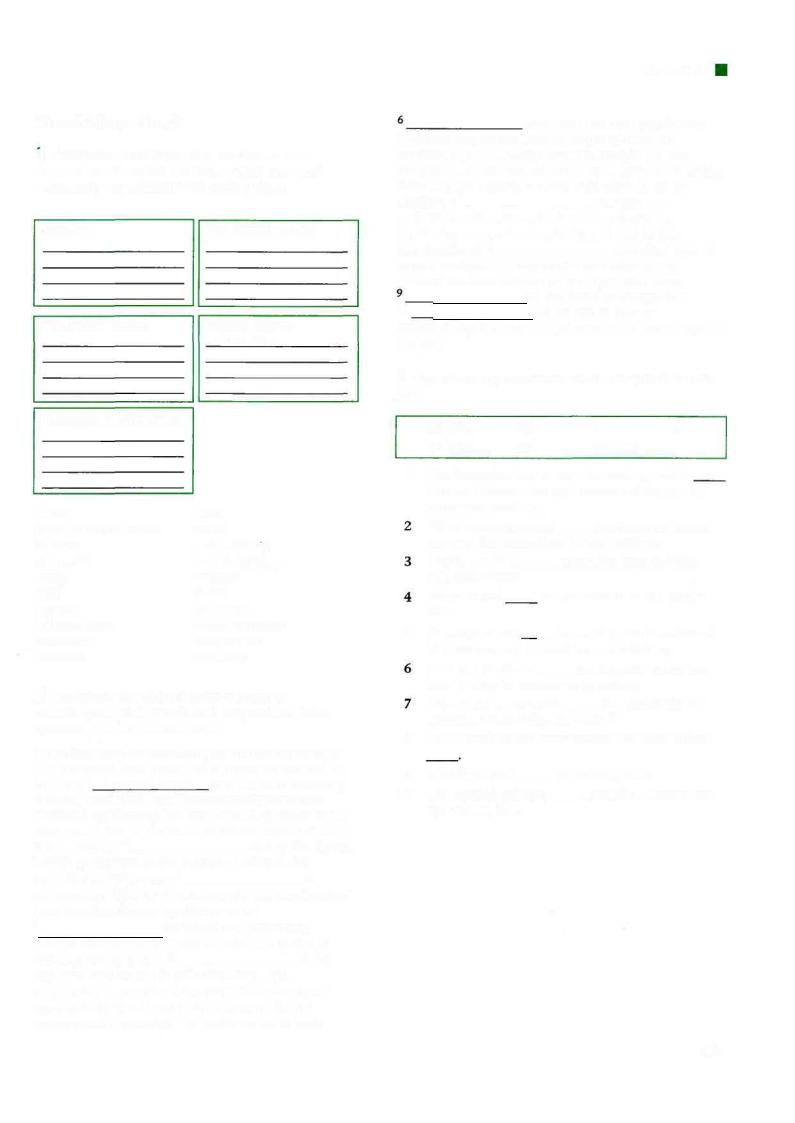
Vocabulary check
I Complete the boxes with the words and expressions from the list below that are most commonly associated with each theme.
Banking |
The Environment |
The Stock Market |
Import Export |
|
t a r i f f s |
Company Performance
tariffs |
quota |
|
chief financial officer |
broker |
|
balance |
sustainability |
|
net profit |
local |
subsidiary |
waste |
revenue |
|
yield |
duties |
|
deposit |
debit |
card |
balance sheet |
global |
warming |
cashpoint |
issue shares |
|
dividend |
recycling |
|
2 Complete the extract from a letter to shareholders with words and expressions from exercise 1 in the correct form.
It has been another excellent year for the company as our businesses have continued to grow. As you will see
from the 1 bcdatvife shefefc. and the accompanying py
financial statements, our financial performance has improved significantly. We are particularly proud of our sales record and of the fact that we are able to report a
6% increase in 2 |
|
during the period. |
||
Thanks to this and to the success of various cost |
||||
reduction initiatives, our3 |
|
|
is |
|
substantially higher and consequently our shareholders have benefited from a significant rise in
4 per share. Our continuing
commitment to the environment, and our policy of
ensuring the long term 5 |
|
of the |
resources that we use in manufacturing, have |
|
|
contributed to our recent success in the new export markets in Eastern Europe where concern for the environment is growing. Our performance in toxic
Review 2
reduction has been significantly improved and we are now on target to meet EU requirements. In the light of our success in the East European markets, we are planning to continue investing there and are moving forward with plans to set up
additional 7 |
|
. However, our |
||
performance in some areas has been affected by |
||||
continuing economic uncertainty and also by the |
||||
introduction of8 |
|
|
restricting sales of |
|
certain products. On the recommendation of our advisers, we have decided to go ahead with plans
10 |
on the Stock Exchange. Our |
will be responsible for |
implementing this new programme in the second half of the year.
3 Complete the sentences using the words in the box.
|
on (x2) |
with |
|
|
for |
of |
|||||||||
|
off (x2) |
into |
|
|
out(x2) |
|
|||||||||
1 |
The magazine has a very interesting article on |
||||||||||||||
|
how to measure the environmental impact of |
||||||||||||||
|
consumer products. |
|
|
|
|
|
|
|
|||||||
|
We're having trouble |
|
|
|
|
|
our agent as he has |
||||||||
|
not met the conditions in the contract. |
||||||||||||||
|
Could you find |
|
|
when the next meeting |
|||||||||||
|
will take place? |
|
|
|
|
|
|
|
|||||||
|
We were cut |
|
|
|
|
in the middle of the phone |
|||||||||
|
call. |
|
|
|
|
|
|
|
|
|
|
|
|
|
|
5 |
The arguments |
|
increasing our |
investment |
|||||||||||
|
in the company are not very convincing. |
||||||||||||||
|
One of the effects |
|
|
|
the financial crisis has |
||||||||||
|
been a drop in consumer spending. |
|
|||||||||||||
|
We are doing research |
|
|
|
|
|
the possibility of |
||||||||
|
|
|
|
|
|
|
|
||||||||
|
opening a new office in Poland. |
|
|||||||||||||
8 The launch of the new version has been called |
|||||||||||||||
9 |
A tariff is a tax |
|
imported goods. |
||||||||||||
10 |
The speaker pointed |
|
|
|
that the information |
||||||||||
|
was incomplete. |
|
|
|
|
|
|
|
|
||||||
105
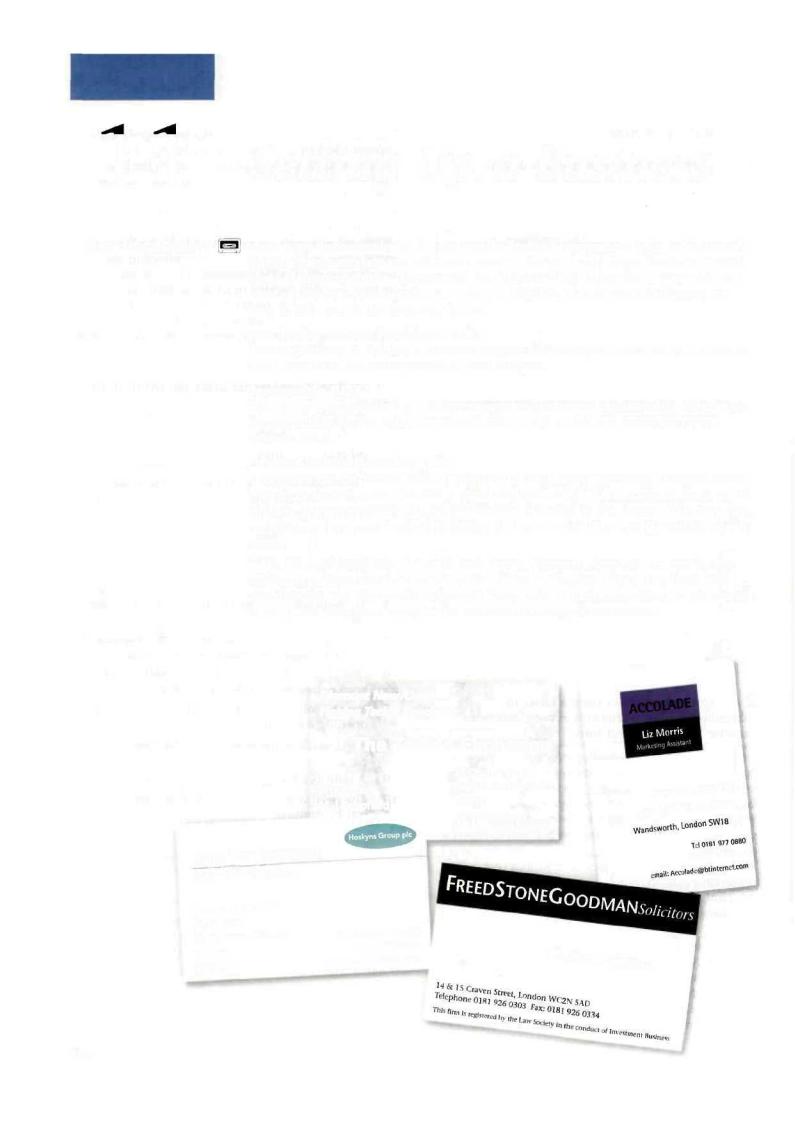
unit
j _ j _ Setting Up a Business
Key vocabulary Many large businesses in the UK are public limited companies (pic), which means that the public can buy and sell their shares on the stock exchange. Examples include Marks & Spencer, British Telecom and the National Westminster Bank. The minimum share capital for a public limited company is £50,000, so many new businesses are likely to take one of the following forms.
Sole Trader or Sole Proprietor (UK)
The simplest way of starting a business. You are self-employed and entirely responsible for all aspects of the management of your business.
Partnership (UK)
Two or more people starting a business together can set up a partnership. All partners are responsible for the debts of the partnership, and profits and losses are shared between them.
Private Limited Company (UK)
A company can be formed with a minimum of two people becoming its shareholders. They must appoint a director and a company secretary. If the company goes out of business, the responsibility of each shareholder is limited to the amount that they have contributed; they have limited liability. Such a company has Ltd (Limited) after its name.
In the US, businesses take the same basic forms. However, American companies are registered or incorporated with the authorities in the state where they have their headquarters. The abbreviations Inc and Corp refer to such companies. To sell shares to the public they must apply to the Securities Exchange Commission.
Discount New/Used
Fishing Tackle Specialist
The Tackle Exchange
|
29 Church Street |
|
|
Proprietor |
Walton-on-Thames |
Accolade Europe U* |
|
Surrey |
|||
M J Schofield |
Bowling House, Point * - * < * • |
||
Tel 01932 24377 |
|||
|
|
||
|
Mobile: 0875 435731 |
|
Jonathan Grinsted
Project Systems Division
Hoskyns Group pic South Bank
95 Wandsworth Road London
SW8 2LX
FacOISI 977 «80
Telephone 0181 735 0800 |
|
Fax: 0181 735 8943 |
|
email: Jonhosk©ndirect.co.uk |
Charles Goodman |
106
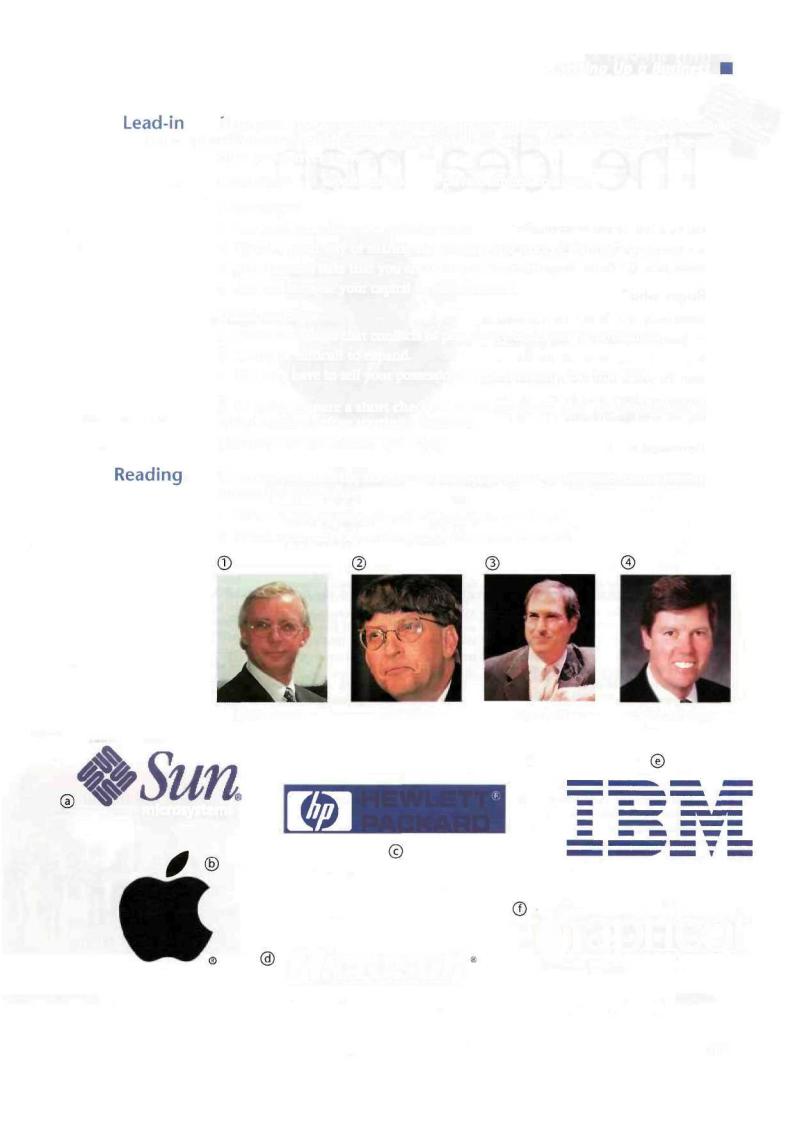
Setting Up a Business
I In pairs, decide which of the advantages and disadvantages below you would associate with the following forms of business. In some cases there may be more than one correct answer.
a sole trader |
a partnership |
a private limited company |
Advantages
1 You have total control of your business.
2This is a good way of sharing the pressure and work of starting a business.
3The financial risks that you are taking are restricted.
4You can increase your capital by selling shares.
Disadvantages
1There is a danger that conflicts of personality could ruin your business.
2It may be difficult to expand.
3You may have to sell your possessions if the company goes into debt.
2 In pairs, prepare a short checklist of the questions that you would need to ask yourselves before starting a business.
Example: How much money will I need?
1 Before you read the text on the next page about a computer entrepreneur, answer the questions.
1 What computer and software companies do you know? 2 Which company below did each of these people create?
RogerFoster |
Bill Gates |
Steve fobs |
Scott McNealy |
microsystems
HEWLETT PACKARD
Microsoft ^apricot
107
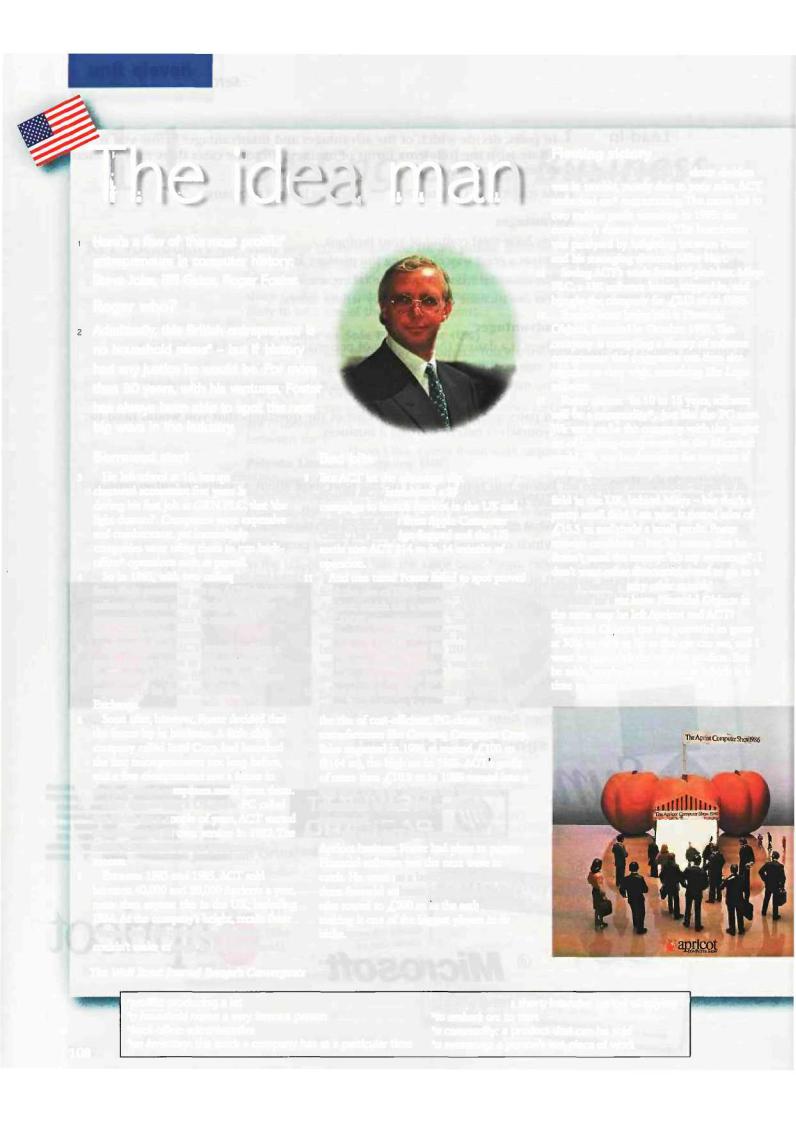
unit eleven
The idea man
Here's a few of the most prolific* entrepreneurs in computer history: Steve Jobs, Bill Gates, Roger Foster.
Roger who?
Admittedly, this British entrepreneur is no household name* - but if history had any justice he would be. For more than 30 years, with his ventures, Foster has always been able to spot the next big wave in the industry.
Borrowed start |
Bad bite |
3He left school at 16, but qualified as a chartered accountant five years later. It was during his first job at GKN PLC, that 'the light dawned'. Computers were expensive and cumbersome, yet increasingly companies were using them to run backoffice* operations such as payroll.
4So in 1965, with two colleagues and loans from their parents he set up ACT, designing software systems and offering computer programming services to corporate accounting departments.
5After two years, ACT started making a profit. In fact, it was so successful that it became, in 1979, the Srst British software company to be listed on the Stock Exchange.
6Soon after, however, Foster decided that the future lay in hardware. A little chip company called Intel Corp. had launched the first microprocessors not long before, and a few entrepreneurs saw a future in small, personal computers made from them.
7After distributing a US-made PC called the Sirius for a couple of years, ACT started manufacturing its own version in 1982. The result, the Apricot, was a phenomenal success.
8Between 1983 and 1985, ACT sold between 40,000 and 50,000 Apricots a year, more than anyone else in the UK, including IBM. At the company's height, recalls Peter Home, one ofApricot's co-founders, 'We couldn't make enough to satisfy demand.'
9But ACT let the advantage slip.
10In 1985 ACT introduced a $7 m advertising campaign to launch Apricot in the US and steal market share from Apple Computer Corp. The campaign flopped and the US sortie cost ACT $14 m in 14 months of operation.
11And one trend Foster failed to spot proved fatal: the rise of IBM-compatible computing. Apricot, which ran a version of Microsoft's MS-DOS operating system, had a hardware architecture peculiar to itself. Foster concedes being late in shifting to the IBM standard; 'If we got the timing wrong, it was six to nine months, not a year,' he says.
12But it was too late. Margins on the Apricot computer began to be squeezed following the rise of cost-efficient, PC-clone manufacturers like Compaq Computer Corp. Sales stagnated in 1986 at around £100 m ($164 m), the high set in 1985. ACT s profit of more than ^10.5 m in 1985 turned into a loss of£15 m in 1986, as the company abandoned its non-IBM-compatible inventory*.
13In the end, ACT was forced to sell the Apricot business. Foster had plans to pursue. Financial software was the next wave to catch. He went on a buying spree*, adding three financial software companies. ACT's sales soared to £200 m m ^ e a r j y 1990s - making it one of the biggest players in its niche.
Fleeting victory
14The company's financial products division was in trouble, mostly due to poor sales. ACT embarked on* restructuring. The move led to two sudden profit warnings in 1995; the company's shares slumped. The boardroom was paralysed by infighting between Foster and his managing director, Mike Hart.
15Seeing ACT's weak financial position, Misys PLC, a UK software house, stepped in, and bought the company for £212 m in 1995.
16Foster's latest brainchild is Financial Objects, founded in October 1995.The company is compiling a library of software components that companies can then slot together as they wish, something like Lego software.
17Foster claims: 'In 10 to 15 years, software will be a commodity*, just like the PC now. We want to be the company with the largest set of banking components in the Microsoft world. We can be dominant for ten years if we do it.'
18The company is the second-largest in its field in the UK, behind Misys - but that's a pretty small field. Last year, it posted sales of £15.5 m and made a small profit. Foster remains confident - but he stresses that he doesn't need the money: 'It's my swansong*. I don't want other directorships and to go to a board meeting every other month.'
19Would he ever leave Financial Objects in the same way he left Apricot and ACT? 'Financial Objects has the potential to grow at 30% to 40% as far as the eye can see, and I want to take it all the way,' he predicts. But he adds, 'maybe there is a size at which it is time to move.'
The WallStreetJournalEurope'sConvergence
'prolific: producing a lot
*o household nome: a very famous person *back-office: administrative
*an inventory: the stock a company has at a particular time
*o buying spree: a short, intensive period of buying
*to embark on: to start
*a commodity: a product that can be sold *a swansong: a person's last piece of work
108

Setting Up a Business
2 Below is a list of some of the things that Roger Foster did at different stages in his career. Read the text and number these events in the order in which they happened.
created ACT |
Q |
bought financial software companies |
sold Apricot |
g |
reorganised ACT |
produced a PC |
h |
started Financial Objects |
moved into the US market |
|
worked for GKN |
changed to a new |
|
|
computer architecture |
|
|
3 Read the text again and find one example of
aan innovation that Roger Foster has been responsible for.
ban opportunity that he has taken.
ca mistake that he has made during his career.
Vocabulary I Find words in the text which correspond to the following definitions.
1 developing new ideas for products and software (para 4)
2writing (and entering) sets of instructions for computers (para 4)
3selling a product made by someone else (para 7)
4making a product in a factory (para 7)
5sell a product for the first time (para 10)
6reorganising (para 14)
2 Match the words from the text with their corresponding definitions.
1phenomenal (para 7) •
2to flop (para 10)
3fatal (para 11)
4 to stagnate (para 12)
5a high (para 12)
6to soar (para 13)
7to be in trouble (para 14) 8 to slump (para 14)
ato have problems
bto stop changing
cto be unsuccessful
dthe maximum point reached
every unusual and impressive
fhaving a very serious effect
gto go down suddenly
hto go up quickly
109
